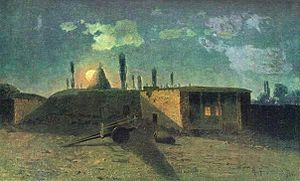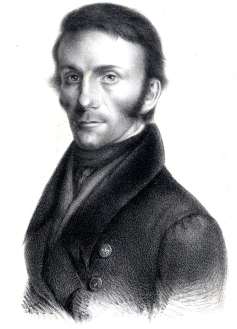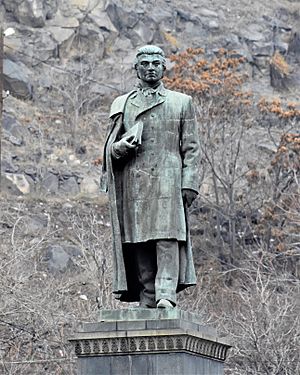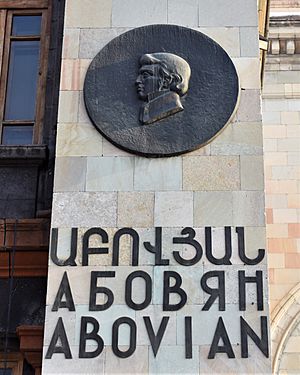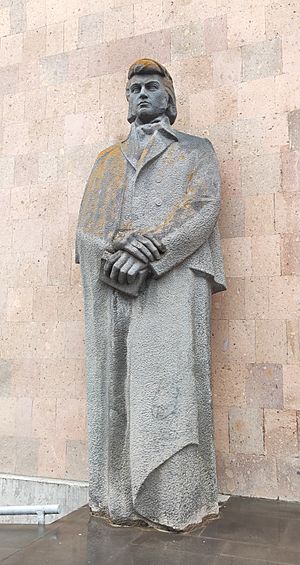Khachatur Abovian facts for kids
Quick facts for kids
Khachatur Abovian
|
|
|---|---|
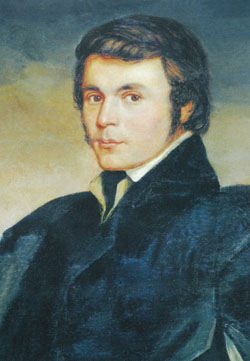
Portrait of Khachatur Abovian, by Ludwig von Maydell (1831)
|
|
| Born | 15 October 1809 Kanaker, Erivan Khanate, Persian Empire (modern-day Yerevan, Armenia) |
| Died | 14 April 1848 (disappeared, presumed dead) |
| Occupation | novelist, playwright, teacher, poet |
| Language | Eastern Armenian |
| Nationality | Armenian |
| Period | Romanticism |
| Spouse | Emilia Looze (m. 1839) |
| Children | 2 children |
Khachatur Abovian (born October 15, 1809 – disappeared April 14, 1848) was a very important Armenian writer and public figure from the early 1800s. He was an educator, poet, and believed in making society more modern.
Many people call him the "father of modern Armenian literature." He is best known for his novel Wounds of Armenia. This book was written in 1841 and published after his disappearance in 1858. It was the first novel written in the modern Armenian language. It used the Eastern Armenian dialect from Yerevan instead of the older Classical Armenian.
Abovian was ahead of his time. Almost none of his works were published while he was alive. He only received wide recognition much later. Today, Abovian is seen as one of the most important people in not just Armenian literature, but in all of Armenian history.
Contents
Early Life and Education
Khachatur Abovian was born in 1809 in a village called Kanaker. At that time, Kanaker was part of the Persian Empire. Today, it is a district of Yerevan, Armenia. His family had a special role as tanuter, which was like a hereditary lordship in Kanaker.
When he was 10, Abovian went to Echmiadzin to study for the priesthood. He left after five years. In 1822, he moved to Tiflis to study Armenian studies and languages. He attended the Nersisyan School there.
Abovian finished school in 1826. He planned to go to Venice to study more. However, the Russo-Persian War (1826–28) stopped his plans. For three years, he taught briefly at Sanahin. Then he worked for Catholicos Yeprem of Armenia as a clerk and translator.
While working for the Catholicos, Abovian met many important foreigners. One was the diplomat and playwright Alexandr Griboyedov. Griboyedov's newspaper, Tifliskiye Vedemosti, was the first to publish an article about Abovian.
Climbing Mount Ararat
A big moment in Abovian's life was when Friedrich Parrot came to Armenia in September 1829. Parrot was a physics professor from the University of Dorpat in Estonia. He came to Armenia to climb Mount Ararat for geological studies. He needed a local guide and translator.
The Catholicos asked Abovian to help Parrot. With Abovian's help, Parrot became the first explorer in modern times to reach the top of Mount Ararat. The Russian emperor Nicholas I supported the trip and sent a military escort.
Abovian and Parrot started their climb from the Armenian village of Akhuri. This village was on the northern side of Ararat. They set up their main camp at the Monastery of St. Hakob. Abovian was one of the last people to visit Akhuri and the monastery. Both were completely destroyed by a big earthquake in May 1840.
Their first attempt to climb the mountain failed because they did not have warm enough clothes. Six days later, they tried again from a different side. They almost reached the top but had to turn back because it was getting dark.
They finally reached the summit on their third try. This happened at 3:15 p.m. on October 9, 1829. Abovian dug a hole in the ice and put up a wooden cross. He even took a piece of ice from the top in a bottle, thinking the water was holy. Abovian climbed Ararat two more times later in his life.
Years in Dorpat

Professor Parrot was impressed by Abovian's desire to learn. So, he arranged for Abovian to get a scholarship from the Russian government. This allowed Abovian to study at the University of Dorpat in 1830. He studied in the Philosophy department from September 1830 to January 1836.
His years in Dorpat (which is now Tartu, Estonia) were very important for Abovian. He studied social and natural sciences, European literature, and philosophy. He also became very good at German, Russian, French, and Latin. During this time, he was influenced by German Romanticism. He also met many important European thinkers.
Returning to Armenia
In 1836, Abovian returned home. He was eager to help educate his people. However, his efforts were often stopped. He faced problems from the Armenian clergy and government officials. This was because he disagreed with old-fashioned ways of teaching.
Abovian became the supervisor of the school in Tiflis. In 1839, he married a German woman named Emilia Looze. In 1843, he was moved to a school in Yerevan. There, he faced indifference and unfriendliness from his coworkers and the clergy.
In the summer of 1843, two German travelers visited Abovian. One was Professor Moritz Wagner from the University of Munich. Abovian traveled with Wagner around the Lake Sevan area. They also climbed Mount Aragats together.
Abovian also became a trusted friend of the Yazidi community in Armenia. He was invited to a tribal feast organized by their chief. In 1846, he started writing articles for the newspaper Kavkaz.
Mysterious Disappearance
On April 14, 1848, Khachatur Abovian left his home for an early morning walk. He was never seen again. His disappearance remains a mystery. His wife, Emilia, did not report him missing for a month. Their children, Vartan and Zarmandukht, were only eight and five years old at the time.
Many ideas have been suggested about what happened to him. Some think he died or was murdered by enemies. Others believe he was arrested and sent to Siberia. One writer, Axel Bakunts, thought Abovian might have gone to Western Europe during the Revolutions of 1848.
His Writings
Abovian wrote many different types of works. These included novels, stories, plays, poems, and fables. He was the first Armenian writer to create literature specifically for children.
The Wounds of Armenia Novel
His historical novel, Wounds of Armenia, was written in 1841. It was first published in 1858. This was the first Armenian novel about the struggles of the Armenian people. It focused on their fight for freedom during the Russo-Persian War of 1826–1828. The novel showed the suffering of Armenians under Persian rule.
The main idea of the novel was to show national pride and love for one's country. It also showed hatred for those who oppressed them. These ideas greatly influenced Armenian society. The hero, Agassi, represents the spirit of freedom and the will to fight against foreign invaders. His motto was: "Give away your life, but never give away your native lands." The story starts with an Armenian girl being kidnapped. This leads to an uprising led by Agassi.
Other Important Works
Abovian's poetry often used satire. A good example is The wine jug, where he criticized Russian bureaucracy. Leisure entertainment was a collection of fables in verse. These fables criticized bad habits, unfairness, and moral decline.
He also wrote non-fiction works like Discovery of America and Book of Stories. Abovian translated works by famous writers into Armenian. These included Homer, Goethe, Friedrich Schiller, and Nikolay Karamzin.
He strongly supported modern education for everyone. He believed schools should be open to all, with free education for poor children. He also thought boys and girls should have equal education. His teaching works include Introduction to education (1838). He also wrote a Russian grammar textbook and an Armenian novel called History of Tigran, or a moral manual for the Armenian children.
Abovian was the first Armenian to study ethnography scientifically. He studied the daily lives and customs of villagers around Kanaker and Yerevan. He also collected and studied Armenian and Kurdish folk stories.
His Lasting Legacy

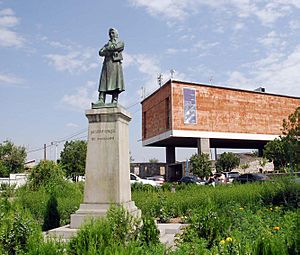
Khachatur Abovian is well remembered in Armenia. He was influenced by the modern teaching ideas of Jean-Jacques Rousseau and Johann Heinrich Pestalozzi.
Many schools, streets, and parks are named after him. The village of Elar, near Yerevan, was renamed Abovyan in his honor in 1961. Two years later, it became a city. His home in Kanaker was turned into a museum in 1939. Many of his original writings are kept there.
Yerevan's State Pedagogical Institute is named after him. In 1964, a special medal was created in his honor. This medal is given to school teachers who are excellent at teaching and educating.
His Portrait
A special portrait of Abovian is displayed at the Charents Museum of Literature and Arts. It is an oil painting. Abovian's grandsons brought it to the museum in 1938. The Armenian painter Gevorg Bashinjagyan restored the painting.
The painter of the portrait was Ludwig von Maydell from Dorpat University. He painted it in the fall of 1830. At that time, Abovian was only 20 or 21 years old. This portrait is the only painting of Abovian made during his lifetime.
Statues Honoring Abovian
There are two important statues of Abovian in Yerevan. The idea for the first statue came in 1908. Armenian thinkers decided to honor the 60th anniversary of Abovian's disappearance. They raised money for a statue.
The statue was designed by M. Grigoryan and sculpted by Andreas Ter-Manukyan in Paris. It is 4.5 meters (about 15 feet) tall. It is made of bronze and stands on a granite base. The statue arrived in Yerevan in 1925. It was first placed on Abovian street in 1933. Later, in 1964, it was moved to its permanent home near the Abovian house-museum in Kanaker.
The second statue of Abovian in Yerevan was put up in Abovian Square in 1950. This bronze statue is 9 meters (about 30 feet) tall. It was designed by Gevork Tamanian and sculpted by Suren Stepanyan.
Films About His Life
Between 1948 and 1984, five documentary films were made in the Armenian SSR about Abovian's life and work. In 2011, a documentary film called Journey to Ararat was made in Estonia. It was about Parrot and Abovian's trip to Mount Ararat. This film was shown at the Golden Apricot International Film Festival in Yerevan in 2013.
See also
 In Spanish: Jachatur Abovián para niños
In Spanish: Jachatur Abovián para niños


